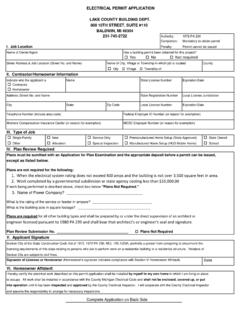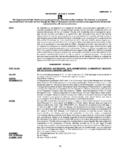Transcription of GENERAL GUIDELINES FOR SUBMITTING …
1 PHARMACEUTICAL REGULATORY AUTHORITY. GENERAL GUIDELINES FOR. SUBMITTING applications . FOR REGISTRATION OF A. MEDICINE. First Edition Table of Contents 1. Foreword 3. 2. Acknowledgements . 4. 3. Definitions and Interpretations .. 5. 4. Abbreviations and Acronyms . 7. 5. Introduction .. 10. PART IA GENERAL Information 13. PART IB Product Profile 17. PART IIA Bioavailability / Bioequivalence data 24. PART IIB Expert reports 24. PART III CHEMICAL AND PHARMACEUTICAL INFORMATION .. 25. PART IIIA Composition PART IIIB Development Pharmaceutics PART IIIC Control of the starting materials Active pharmaceutical ingredients (API). Excipient(s). PART IIID Packaging material (immediate packaging).
2 PART IIIE Control tests on intermediate products (if necessary). PART IIIF Control tests on the finished product PART IIIG Method of preparation for the finished product PART IIIH Stability tests on the finished product 11. PART IV Summary of toxico-pharmacological documentation of a medicine Brief summary . 29. PART IVA Single dose toxicity PART IVB Repeat dose toxicity PART IVC Reproduction studies PART IVD Genotoxicity PART IVE Carcinogenicity PART IVF Pharmacodynamics PART IVG Pharmacokinetics PART IVH Local tolerance PART IVJ Other toxicity studies (if available). (i) Antigenicity (ii) Immunotoxicity (iii) Dependence (iv) Studies on metabolites (v) Studies on impurities (vi) Other studies Discussions and Conclusions 12.
3 PART V Summary of clinical studies 33. PART VA Human pharmacology (i) Pharmacodynamics 1. (ii) Pharmacokinetics Summary of clinical pharmacology studies Product Development Rationale Summary of Bio pharmaceutics (BC) studies and associated analytical methods PART VB Clinical documentation Summary of clinical efficacy Summary of clinical safety ANNEX I Recommended wordings of warnings on packages .. 47. Other warnings 50. ANNEX II Colours permitted in medicinal products 53. ANNEX III ATC 55. ANNEX IV Application form 68. 2. Foreword The Pharmaceutical Act (No. 14) of 2004 requires that medicinal products intended to be marketed in Zambia meet acceptable standards of quality, safety and efficacy and at the same time be assessed to have been manufactured in facilities which comply with current Good Manufacturing Practices (cGMP).
4 One of the means for ensuring that medicinal products meet the required standards of quality, safety and efficacy is by conducting product specific pre-marketing assessments to determine whether the product should be registered. These GUIDELINES have been prepared to provide information to applicants who intend to register medicinal products for human use in Zambia. This document has been developed by the Pharmaceutical Regulatory Authority (PRA) to provide guidance to applicants on the content and format of the dossier in respect of products submitted for registration. These GUIDELINES also indicate the order of the material to be submitted and the minimum requirements for product registration.
5 Compliance to these GUIDELINES in the submission of applications will facilitate the speedy processing and evaluation of the applications and subsequent registration of the products. This will enable the product prospective licence holders to market their products on time and make them available to the consumers in a timely manner. It is therefore my sincere hope that these GUIDELINES will provide the necessary information in preparing and SUBMITTING documents for registration of medicinal products for human use in Zambia. Finally, I wish to urge our esteemed readers and applicants to read this first edition of GUIDELINES carefully and make as many suggestions as possible so that we have a version of the GUIDELINES that are commensurate with current practices.
6 Dr Miti PERMANENT SECRETARY. Ministry of Health 3. Acknowledgements The Ministry of Health (MoH) and the Pharmaceutical Regulatory Authority (PRA) wish to acknowledge the immense contributions of individuals and originations that constituted the Technical Working Group in developing these GUIDELINES . The principal contributors for this guidance document were: 1. Mr Ng'uni: Pharmaceutical Society of Zambia 2. Ms Esnat Mwape: Director GENERAL , PRA. 3. Dr G. Chishimba: Medical Practitioner, National AIDS Council 4. Ms Anne Zulu: Pharmacist, Medical Stores Limited 5. Dr K Choongo: Lecturer, UNZA School of Veterinary Medicine 6. Ms Loyce Lishimpi: National Profession Officer, WHO. 7. Mrs Bernice C.
7 Mwale: Director-Product Registration, PRA, 8. Mr. Felix P. Chizu: Regulatory Officer, PRA. 9. Dr Zuma Munkombwe: Regulatory Officer, PRA. 10. Mr. Pelekelo Mangisha: Assistant Regulatory Officer, PRA. The MoH and PRA would further like to thank the World Health Organisation (WHO). for providing financial and technical support to the development of these GUIDELINES . Ms E. Mwape DIRECTOR- GENERAL . Pharmaceutical Regulatory Authority 4. Definitions & Interpretations Active pharmaceutical ingredient (API) means a substance or compound that is intended to be used in the manufacture of a pharmaceutical product as a therapeutically active compound (ingredient). Authority Means the Pharmaceutical Regulatory Authority established under Section 4 of the Pharmaceutical Act No 14 of 2004.
8 Bio-equivalence Two pharmaceutical products are bioequivalent if they are pharmaceutically equivalent or alternatives and their bio-availabilities (rate and extent of availability), after administration in the same molar dose, are similar to such a degree that their effects can be expected to be essentially the same. Composition Composition in relation to a medicinal product means the ingredients of which it consists, proportions, degree of strength, quality and purity in which those ingredients are contained. Container Means a bottle, jar, box, packet, sachet or other receptacle which contains or is to contain in it, not being a capsule or other article in which the product is or is to be administered or consumed, and where any such receptacle is or is to be contained in another receptacle, includes the former but does not include the latter receptacle.
9 Container labelling Means all information that appears on any part of a container, including that on any outer packaging such as a carton. Medicines, Medicinal or Pharmaceutical product Medicine" means any substance or mixture of substances which is used or is manufactured, sold or represented as suitable for use in the diagnosis, treatment, mitigation or prevention of disease or abnormal physical or mental state or the symptoms thereof in man, or in animal; or restoring, correcting or modifying any physical, mental or organic function in man or in animals. Established active pharmaceutical ingredient Means APIs which are subject of the current pharmacopoeias or those well documented in the literature and generally recognized as safe and effective for use as a medicine.
10 Excipient Means any component of a finished dosage form which has no therapeutic Value Expert report Means a summary and interpretation of data, with conclusions, prepared by an independent competent person. 5. Finished product Means a product that has undergone all stages of production, including packaging in its final container and labelling Formulation Means the composition of a dosage form, including the characteristics of its raw materials and the operations required to process it. GENERAL sale Medicines (GS). Means any Medicines whose use does not need the direction or prescription by a Veterinary surgeon or dentist. Generic products Means products that are pharmaceutical equivalents or alternatives to innovator or reference products and which are intended to be therapeutically equivalent and can therefore be used interchangeably with the innovator or reference product.













